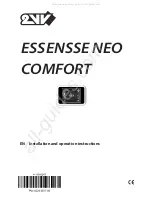
24 | BA-40100-02-V17
TOPAX
®
DX
Multichannel controller
A acknowledging potentiometer can not be connected with servo motors
with position feedback (1 - 10 kOhm). The acknowledging potentiom-
eter is to be adjusted. For calibration the servomotor is started first.
The voltage, which lines up over the acknowledging potentiometer, is
indicated in the position of the potentiometers (voltage display between
0 and 3 V). After the stop position has been reached, the servomotor
is stopped automatically. The alignment is accomplished and is to be
stored in the TOPAX DX.
The switching hysteresis can be set from 1 - 20%.
ATTENTION!
If during ongoing operation, due to faults or the like,
the end position and/or the zero point is not reached
after approx. 10 minutes, the “Servo motor alarm”
error message will be displayed. The error tolerance
is coupled to the switching hysteresis of the “3-point
step” control type. .
A servo actuator without feedback can also be operated. This is to be
selected with the configuration.
If no positional feedback is available, measure and adjust the motor life
(see chapter “19.1.12 Menu 5: Services” on page 35).
ATTENTION!
Entering a wrong motor life may prevent accurate
controller functioning. In this case you would receive
no warranty coverage by the manufacturer. The mo-
tor cycle time is set by the factory at 120 seconds
which corresponds to the cycle time of the motor of
the chlorine gas valve C7700.
7.1.5 Continuous control output (20 mA current output)
For automatic controllers a continuous control output of 0/4...20 mA can
be configured for the control of continuous actuators.
The current varies between 0 and 20 mA depending on the deviation.
Max. load: 500 ohms
The 20 mA current output for disinfection is switched on for every con-
figuration.
You can choose between:
• 0...20 mA
• 4...20 mA
• 20...0 mA and
• 20...4 mA
7.2 Output restriction
The maximum output of each controller can be restricted. To do this,
enter the maximum percentage value the actuator can reach.
Example: If a value of 80 % operates the automatic controller to a max-
imum of 80 %. The algorithm of the automatic control is however com-
puted further on 100 %. Note that the controller parameters are selected
accordingly.
The lowest maximum setting is "50 %".
This limit is useful if for example an oversized dosing pump has been
fitted. This will ensure precise control.
7.3 Actuator
Components such as pumps and solenoid valves, which are controlled
by the TOPAX DX, are called actuators.
Depending on the final control element used, different control functions
can be set. Possible options are a continuous output with impressed
current (0/4...20 mA), or control outputs (with pulse frequency). The lat-
ter can be controlled as electronic (optocoupler) or relay outputs.
8 Controller explanation
8.3.1 Definitions
Term
Definition
actual value (X)
The actual value of X of the measurement for the
respective sensor is constantly indicated.
Setpoint (W)
Setpoint W of a control system defines the level at
which the controller should settle the process and
keep it constant.
Control deviation
(X-W)
Control deviation X-W occurs if the actual value X of
the measurand differs from setpoint W. Control variable
Y results from the control deviation and the control
parameters set.
Control variable Y
Control variable Y of a control system defines the
value which the controller transmits to the final control
element depending on the parameters set and control
deviation X-W (between 0 % and 100 %).
8.1 Proportional controller (P controller)
8.1.1 Proportional range Xp
(proportional effect or amplification of the controller)
The proportional range Xp (p-range) of a proportional controller indicates
the amount by which the measurand X must deviate from the setpoint
W, so that the control variable Y = 100 %. If the control deviation is less,
the control variable is reduced proportionally.
Control variable Y of a P-controller is affected proportionally only by the
control deviation (X - W).
The P-range is indicated in "%" and always refers to the measuring
range final value.
The proportional range is thus an indirect measure of the controller am-
plification K
R
:
K
R
= 100 % / Xp %
For a P gain of 50 % the control amplification is accordingly:
100 /50 = 2 -> controller amplification K
R
= 2
Xp = 50 % means that the control variable Y changes 100 % if the ac-
tual value deviates by 50 % from the setpoint (related to the measuring
range final value).
8.2 Proportional-integral-derivative controller (PIPI, PID
controller)
8.2.1 Reset time Tn
(integral effect of PI controller)
The integral time of a PI or PID controller is called the reset time Tn.
The integral time is the time required by the control variable Y with a
constant nominal/actual deviation to achieve the same change in output
signal as produced immediately by the P proportion immediately after
the change in the nominal/actual deviation.
8.2.2 Example of proportional range and reset time
Xp = 50 % (amplification = 2)
Tn = 3min
(sudden change of the actual value by 15 %)
Содержание TOPAX DX
Страница 59: ...BA 40100 02 V17 59 Operating instructions...
















































